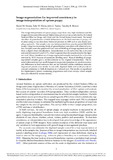JavaScript is disabled for your browser. Some features of this site may not work without it.
| dc.contributor.author | Simms, Daniel M. | |
| dc.contributor.author | Waine, Toby W. | |
| dc.contributor.author | Taylor, John C. | |
| dc.contributor.author | Brewer, Timothy R. | |
| dc.date.accessioned | 2019-11-14T15:55:48Z | |
| dc.date.available | 2019-11-14T15:55:48Z | |
| dc.date.issued | 2016-02-18 | |
| dc.identifier.citation | Simms DM, Waine TW, Taylor JC, Brewer TR. (2016) Image segmentation for improved consistency in image-interpretation of opium poppy. International Journal of Remote Sensing, Volume 37, Issue 6, pp. 1243-1256 | en_UK |
| dc.identifier.issn | 0143-1161 | |
| dc.identifier.uri | https://doi.org/10.1080/01431161.2016.1148290 | |
| dc.identifier.uri | http://dspace.lib.cranfield.ac.uk/handle/1826/14736 | |
| dc.description.abstract | The image-interpretation of opium poppy crops from very high resolution satellite imagery forms part of the annual Afghanistan opium surveys conducted by the United Nations Office on Drugs and Crime and the United States Government. We tested the effect of generalization of field delineations on the final estimates of poppy cultivation using survey data from Helmand province in 2009 and an area frame sampling approach. The sample data was reinterpreted from pan-sharpened IKONOS scenes using two increasing levels of generalization consistent with observed practice. Samples were also generated from manual labelling of image segmentation and from a digital object classification. Generalization was found to bias the cultivation estimate between 6.6% and 13.9%, which is greater than the sample error for the highest level. Object classification of image-segmented samples increased the cultivation estimate by 30.2% because of systematic labelling error. Manual labelling of image-segmented samples gave a similar estimate to the original interpretation. The research demonstrates that small changes in poppy interpretation can result in systematic differences in final estimates that are not included within confidence intervals. Segmented parcels were similar to manually digitized fields and could provide increased consistency in field delineation at a reduced cost. The results are significant for Afghanistan’s opium monitoring programmes and other surveys where sample data are collected by remote sensing. | en_UK |
| dc.language.iso | en | en_UK |
| dc.publisher | Taylor and Francis | en_UK |
| dc.rights | Attribution-NonCommercial 4.0 International | * |
| dc.rights.uri | http://creativecommons.org/licenses/by-nc/4.0/ | * |
| dc.title | Image segmentation for improved consistency in image-interpretation of opium poppy | en_UK |
| dc.type | Article | en_UK |
Files in this item
The following license files are associated with this item:
This item appears in the following Collection(s)
-
Staff publications (SWEE) [2805]

